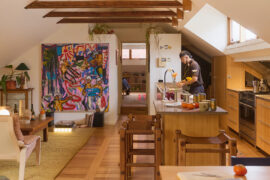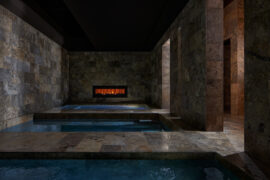As we work ever-more desperately towards a more sustainable future, the really smart people see the solutions as only partly technological. Many answers may lie in a simpler, less wasteful past.
June 6th, 2008
Well, maybe not so far in the past because, until fairly recently, Central Asian nomads took their homes with them. These pastoral nomads had their own stock, homes and transport and followed the seasons, having to endure the extremes of climate from freezing cold winters to searing summers.
Commonly referred to as a yurt, the Turkmen tent was a self-supporting, felt-covered trellis tent which could be collapsed and then carried on a camel’s back. Strictly-speaking, it should be called an oi (meaning the structure of the house), because yurt refers to the land on which the tent stands and, according to Ross Langlands from Sydney’s Nomadic Rug Traders, it “incorporates connotations of territory, birthplace and connection with the smallest unity of society, the family.”
The oi is a dome-shaped structure about five metres in diameter with a smoke hole at the top. With its earth floor and view of the sky up through the smoke hole, the oi was seen as a microcosm of the universe – the earth and the heavens brought together.
The oi could be erected in about an hour and was divided into four quadrants: the front two for domestic use and the rear two for sleeping and entertaining.
A number of elements made up the oi, the most important being the main carpet which would be laid out on special occasions. Other elements were the ensi (the tent door rug), the doorway surround (kapanuk), storage bags (jovals), smaller domestic bags (torbas, djollars) and the tent pole cover (ok bash). These and other woven items – weaving, including the weaving of tribal carpets, was done by the women – lined the inside walls of the tent and helped climate control, keeping the tent warm in winter and cool in summer.
In its own way, therefore, the oi exemplified the principle of the unity of form and function – one might even say it embodies the Vitruvian principles of commodity, firmness and delight. The oi is an ideal structure in that (in material terms) it uses no more or less than it needs, it fulfils all its functions in a simple and uncomplicated way, and is at the same time aesthetically pleasing with a perfect fusion of aesthetic delight and utility.
Dare we say, it is a model of sustainability? You can see for yourself next December when Nomadic Rug Traders, specialists in tribal artefacts from Central and South-East Asia, have their annual showing of their own yurt, erecting it in the gallery with a selection of artefacts typical of the Central Asian nomadic lifestyle.
Nomadic Rug Traders
(61 2) 9660 3753,
INDESIGN is on instagram
Follow @indesignlive
A searchable and comprehensive guide for specifying leading products and their suppliers
Keep up to date with the latest and greatest from our industry BFF's!

London-based design duo Raw Edges have joined forces with Established & Sons and Tongue & Groove to introduce Wall to Wall – a hand-stained, “living collection” that transforms parquet flooring into a canvas of colour, pattern, and possibility.

Adelaide will debut its first city-wide design festival – every*where: Adelaide Design Week – from 20th to 24th August 2025.
Shoehorning this clinic into an existing office demanded a shrewd approach – making the most of limited space and time. Owen Lynch reports
The internet never sleeps! Here's the stuff you might have missed

Continually making its presence felt on the architecture and design scene, DKO has seen a plethora of promotions across its studios in mid-year.

Experience sustainability and luxury in one unforgettable stay! Alba Thermal Springs joins the Sustainability Summit as our exclusive prize partner.

Hogg & Lamb’s Albion Bathhouse has been awarded The Health & Wellbeing Space at the INDE.Awards 2025. The project reimagines the contemporary bathhouse as an immersive architectural journey – one that restores balance through atmosphere, materiality and mindful design.